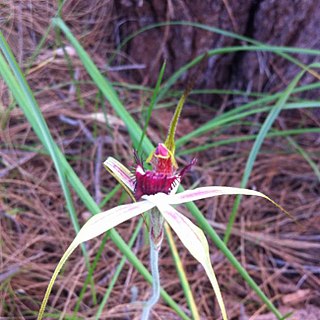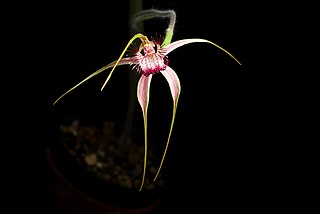
Caladenia paludosa, commonly known as the swamp spider orchid, is a species of orchid endemic to the south-west of Western Australia. It has a single erect, hairy leaf and up to three red, greenish-yellow and cream-coloured flowers. It mostly grows in dense scrub and is one of the last of the similar spider orchids to flower.

Caladenia arenicola, commonly known as the carousel spider orchid, is a plant in the orchid family Orchidaceae and is endemic to the south-west of Western Australia. It has a single erect, hairy leaf and up to three red, white and green flowers on a flowering stem up to 60 cm (20 in) high. It is a common species on the Swan Coastal Plain, where it grows in sandy soil under trees.

Caladenia plicata, commonly known as the crab-lipped spider orchid, is a species of orchid endemic to the south-west of Western Australia. It has a single hairy leaf and one or two red, yellow and pale green flowers with an unusual labellum which vibrates in the slightest breeze.

Caladenia ensata, commonly known as the stumpy spider orchid, is a species of orchid endemic to the south-west of Western Australia. It is a common orchid within its natural range and has a single, hairy leaf and up to three pale yellow and red flowers which have short but thick, fleshy glandular tips.

Caladenia falcata, commonly known as the fringed mantis orchid, is a species of orchid endemic to the south-west of Western Australia. It is a relatively common orchid within its natural range and has a single, hairy leaf and one or two green, yellow and red flowers with spreading petals and upswept lateral sepals.

Caladenia ferruginea, commonly known as the rusty spider orchid, is a species of orchid endemic to the south-west of Western Australia. It has a single, hairy leaf and up to four rust-coloured flowers with a white, red-tipped labellum.

Caladenia footeana, commonly known as the crimson spider orchid is a species of orchid endemic to the south-west of Western Australia. It has a single, hairy leaf and one or two, relatively small pinkish-red flowers with a white, red-striped labellum. Its relatively small size makes it hard to find in its surroundings.

Caladenia gardneri, commonly known as the cherry spider orchid, is a species of orchid endemic to the south-west of Western Australia. It has a single, hairy leaf and up to three pale pink, sweetly scented flowers with a dark pinkish-red labellum.

Caladenia georgei, commonly known as the tuart spider orchid, is a species of orchid endemic to the south-west of Western Australia. It has a single, hairy leaf and up to three whitish to yellowish-green flowers flushed with red and which have a white labellum with a red tip.

Caladenia heberleana, commonly known as Heberle's spider orchid, is a species of orchid endemic to the south-west of Western Australia. It has a single, hairy leaf and up to three red, white and pale yellow flowers which have a white, red-tipped labellum.
Caladenia hiemalis, commonly known as the dwarf common spider orchid is a species of orchid endemic to the south-west of Western Australia. It has a single, hairy leaf and one or two, cream-coloured flowers with a small, red-striped labellum. It has an early flowering period and its flowering is stimulated by summer fires.

Caladenia hirta subsp. hirta, commonly known as the sugar candy orchid or candy orchid, is a plant in the orchid family Orchidaceae and is endemic to the south-west of Western Australia. It has a single leaf and up to three creamy-white or pink flowers with brownish tips and a brown back.
Caladenia hoffmanii, commonly known as Hoffman's spider orchid is a species of orchid endemic to the south-west of Western Australia. It has a single, hairy leaf and one or two, greenish-yellow, red and white flowers which have a greenish-yellow labellum with a red tip. It is distinguished from the Pingaring spider orchid by small differences in the labellum and more northerly distribution.
Caladenia incrassata, commonly known as the puppet clown orchid is a species of orchid endemic to the south-west of Western Australia. It has a single, hairy leaf and usually only one greenish-yellow and red flower which has a red-striped labellum.

Caladenia pendens subsp. talbotii, commonly known as Talbot's spider orchid, is a plant in the orchid family Orchidaceae and is endemic to the south-west of Western Australia. It has a single hairy leaf and one or two white, red and yellow flowers with long drooping petals and sepals and sometimes has a citrus-like scent.

Caladenia pulchra, commonly known as the slender spider orchid, is a species of orchid endemic to the south-west of Western Australia. It has a single erect, hairy leaf and up to three red, yellow and white flowers, although the relative amount of each of these colours is variable.

Caladenia serotina, commonly known as the Christmas spider orchid, is a species of orchid endemic to the south-west of Western Australia. It has a single erect, hairy leaf and up to three white to cream-coloured and red flowers, although the relative amount of each is variable. It is one of the later-flowering spider orchids and occurs in the far south-west corner of the state.

Caladenia thinicola, commonly known as the Scott River spider orchid, is a species of orchid endemic to the south-west of Western Australia. It has a single erect, hairy leaf and up to four yellowish-green and red flowers with a fringe of long teeth on the sides of the labellum and thick brown, club-like glandular tips on the sepals.

Caladenia uliginosa subsp. uliginosa, commonly known as the dainty spider orchid, or darting spider orchid is a plant in the orchid family Orchidaceae and is endemic to the south-west of Western Australia. It has a single hairy leaf and up to four greenish-cream flowers which have a forward-projecting labellum with a dark red tip.

Caladenia valida, commonly known as the robust spider orchid, is a plant in the orchid family Orchidaceae and is endemic to south-eastern continental Australia. It is a ground orchid with a single sparsely hairy leaf and up to three white to cream-coloured flowers which sometimes have red streaks. It is similar to Caladenia reticulata but is large and taller with more stiffly spreading lateral sepals and petals.

















